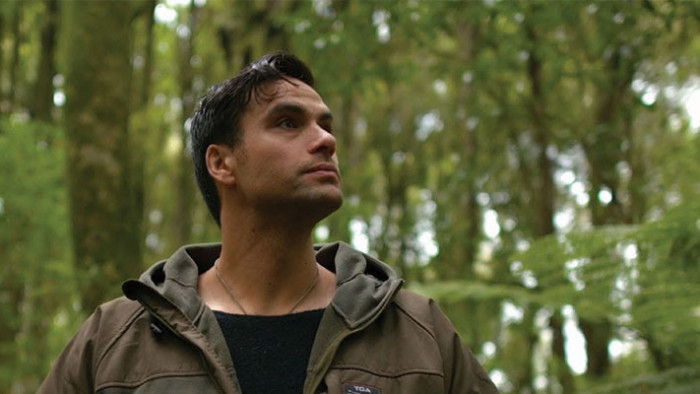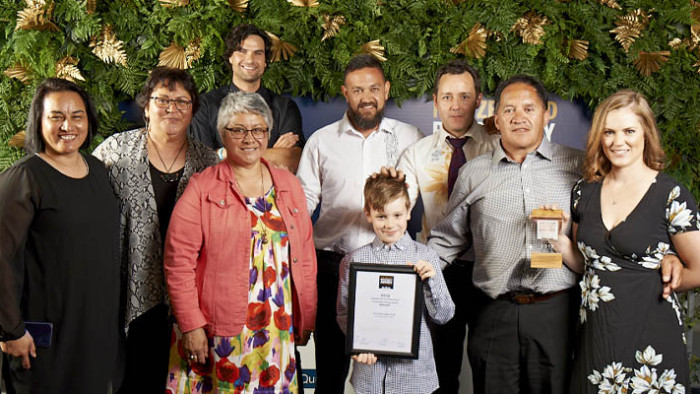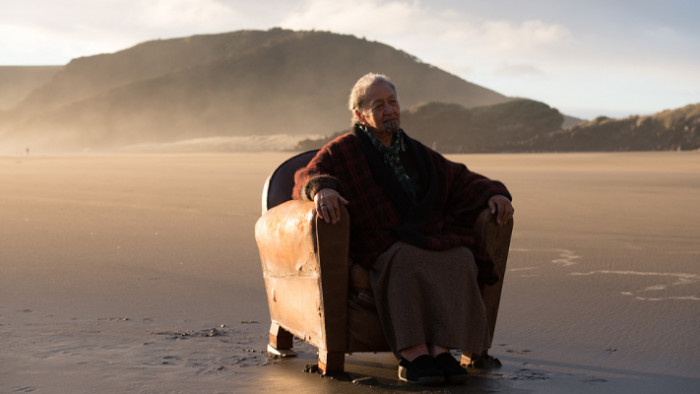2018 Biosecurity Awards finalists and winners
The New Zealand Biosecurity Awards are an annual event, with the first Awards held in 2017.
Get inspired by the 2018 winners and their stories below.
There were eight award categories in 2018. We announced 19 finalists from seven categories on 12 October 2018. The 2018 New Zealand Biosecurity Awards winners were announced on 12 November 2018 at the Awards dinner in Auckland.
New Zealand Biosecurity Supreme Award & Eagle Technology Local and Central Government Award
Winner: Environment Southland - New Zealand Biosecurity Supreme Award and Eagle Technology Local and Central Government Award
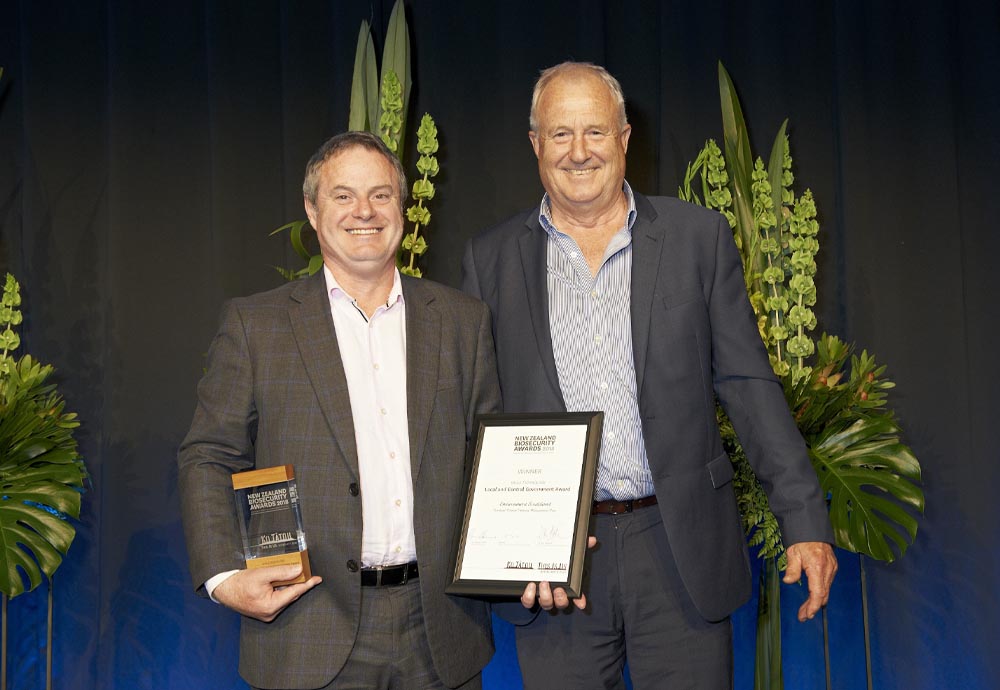
Project: Fiordland Marine Pathway Management Plan
With its breathtaking scenery and pristine waters, Fiordland is one of New Zealand's most unique and nationally significant areas – ecologically and economically. It is vital to protect it. Many local and visiting vessels move in and out of the Fiordland Marine Area on a regular basis, each of them carrying the risk of bringing an unwanted marine pest, which could jeopardise the wellbeing of this special area.
A project group developed the Fiordland Marine Regional Pathway Management Plan (Pathway Plan) to reduce this risk by minimising the pathways for pests. The plan developed under the Biosecurity Act 1993, which is the first of its kind in New Zealand, puts in place rules for all vessels entering the area and requires them to obtain a Clean Vessel Pass, ensuring they know and mitigate any risks.
The development of a formal proposal for a plan was approved in 2014 and the plan was formally adopted and implemented in April 2017. The plan requires a significant degree of voluntary compliance, along with a more formal compliance programme, which is carried out through a joint-agency arrangement.
Environment Southland is responsible for administering the plan. However, its approach to marine biosecurity is very much joint-agency with equal contributions from MPI and DOC as well as the Fiordland Marine Guardians, who are its advisors for such work.
Finalist: Northland Regional Council Pest Control Hub - Eagle Technology Local and Central Government Award
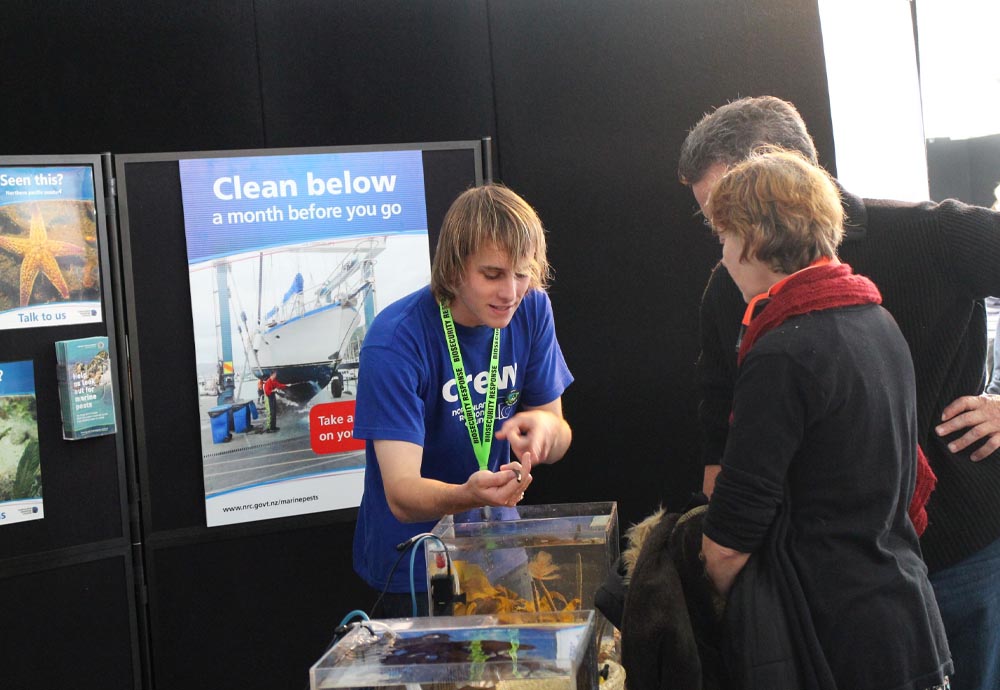
Project: Northland Regional Council Pest Control Hub
The Pest Control Hub has been developed by the Northland Regional Council as a key tool for reaching biosecurity objective in the Northland Regional Pest and Marine Pathways Plan 2017-2027. The intent behind the design was to create a 'one stop shop' for everything regional biosecurity, the site includes an easy to use search function, pest control advice and information, pest distribution maps, rules and online forms to contact staff for more advice or to report a pest.
Minister's Biosecurity Award
Winner: Greg Corbett, Biosecurity Manager, Bay of Plenty Regional Council - Minister's Biosecurity Award
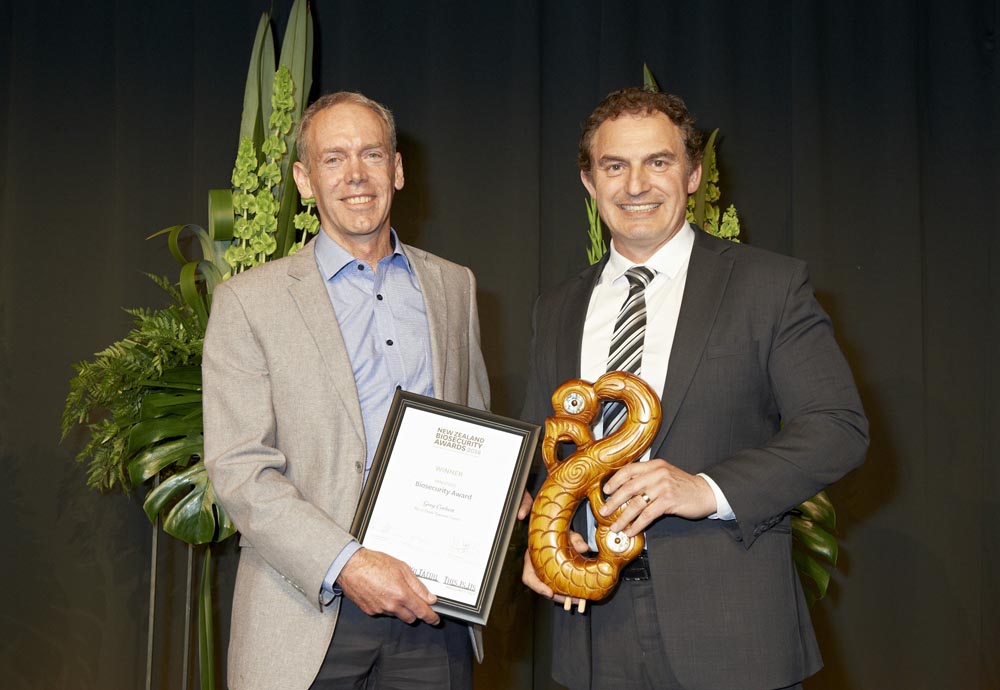
Greg Corbett has been protecting New Zealand’s farms, forests and waterways from animal pests since 1983. He started his career as an agricultural pest destruction council trainee at the age of 17 with a focus on night-shooting for rabbit control. Today he works as the biosecurity manager for Bay of Plenty Regional Council. There he is leading staff and multi-agency collaborative groups to quantify risk, and develop and deliver innovative monitoring and control methods to tackle emerging new threats to the region’s economy and environment, such as from catfish, dama wallabies and marine pests.
Throughout his career to date, Greg has shown unwavering commitment to growing the pool of biosecurity knowledge and management tools, and has been a key player in a range of biosecurity innovations. He has a proven track record of bringing people, agencies and resources together, and empowering staff and communities, to achieve more as a whole than each could deliver alone.
Greg's practical pest management expertise, spirit of cooperation, ability to lead and empower, and his lifetime commitment to innovation and positive environmental outcomes are what make him so deserving of this award.
Department of Conservation Community Award
Winner: Pirongia Te Aroaro o Kahu Restoration Society - Department of Conservation Community Award
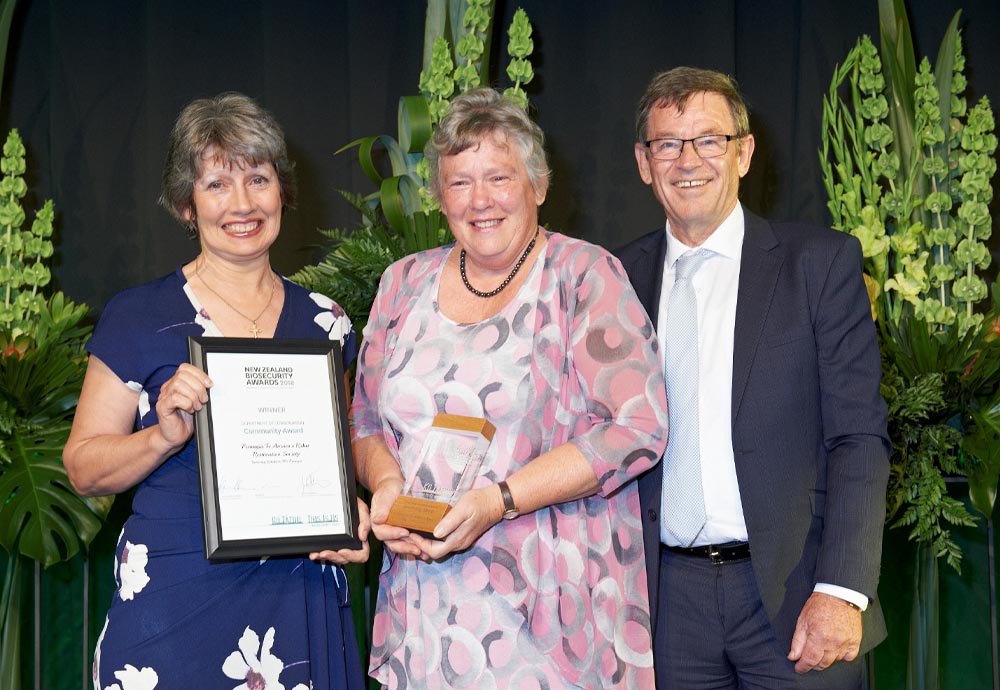
Project: Restoring kōkako to Mt Pirongia
Pirongia Te Aroaro o Kahu Restoration Society (PTAKRS) is a voluntary group based in the Waikato. The group manages pests at two 1,000 hectare sites with the goal of restoring kōkako to the area.
The group's work has led to a range of important outcomes, including:
- the discovery of kōkako with Pirongia DNA
- funding of research into kōkako genetic diversity
- inspiring wider public involvement in protecting a key remnant population at Okahukura within the Northern Pureora Forest (a population now recognised as the strongest in the country).
The classification for kōkako as a species has improved from 'threatened' to 'at risk' thanks to the group's work, and kōkako have been restored to Mt Pirongia.
Finalist: The Forest Bridge Trust - Department of Conservation Community Award
Project: Forest Bridge Trust CatchIT Programme
CatchIT is based on the idea that biosecurity successes are built from the ground up. Partnering with schools, the programme trains students to set up traps and monitoring devices to conduct pest control in their backyards with the help of their parents and whānau. The programme also conducts in-depth pest control workshops for the wider community.
In collaboration with the University of Auckland, CatchIT develops children from hands-on trappers to environmental decision-makers, supporting them to experiment, strategise, and make data-informed decisions. A recent development of this programme – CatchIT hubs – supports community pest control projects on and around key reserves and covenants.
Finalist: Sanctuary Mountain Maungatautari - Department of Conservation Community Award
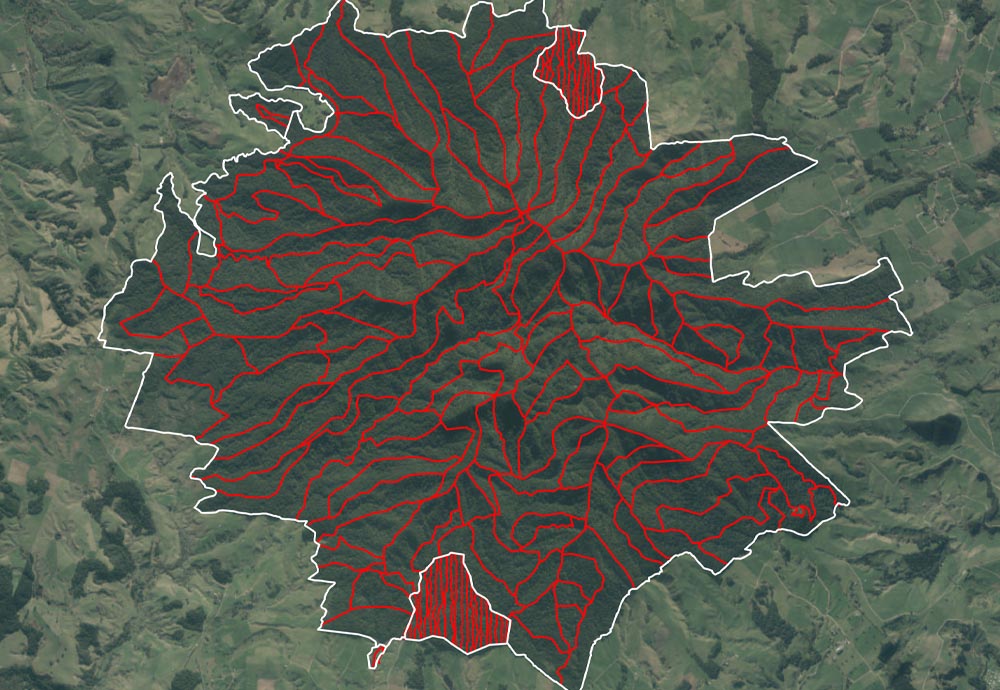
Project: Sanctuary Mountain Maungatautari
Sanctuary Mountain Maungatautari is New Zealand's largest pest-proof fenced sanctuary. With a 47km long Xcluder® fence enclosing 3,400 hectares of old growth bush, it is one of New Zealand's most ambitious biosecurity and conservation projects. The Sanctuary Mountain project began with a dream to protect and enhance the diversity of plant and animal species living on Maungatautari. This dream has been a working reality for the last 12 years.
Governed by a unique trust structure where local iwi, mana whenua, landowners, and local community members are equally represented, Sanctuary Mountain Maungatautari is further supported by over 400 active volunteers, many of whom have been involved with the project for years.
A valuable contributor to the natural, social, cultural, and historical capitals of the region, Sanctuary Mountain Maungatautari has recently partnered with Kiwis for Kiwis to release 500 kiwis over the next 5 years to Maungatautari - a testament to the success of the Project's stringent operational practices and conservation efforts.
Te Puni Kōkiri Māori Award
Winner: Te Rūnanga o Ngāi Te Rangi Iwi Trust - Te Puni Kōkiri Māori Award
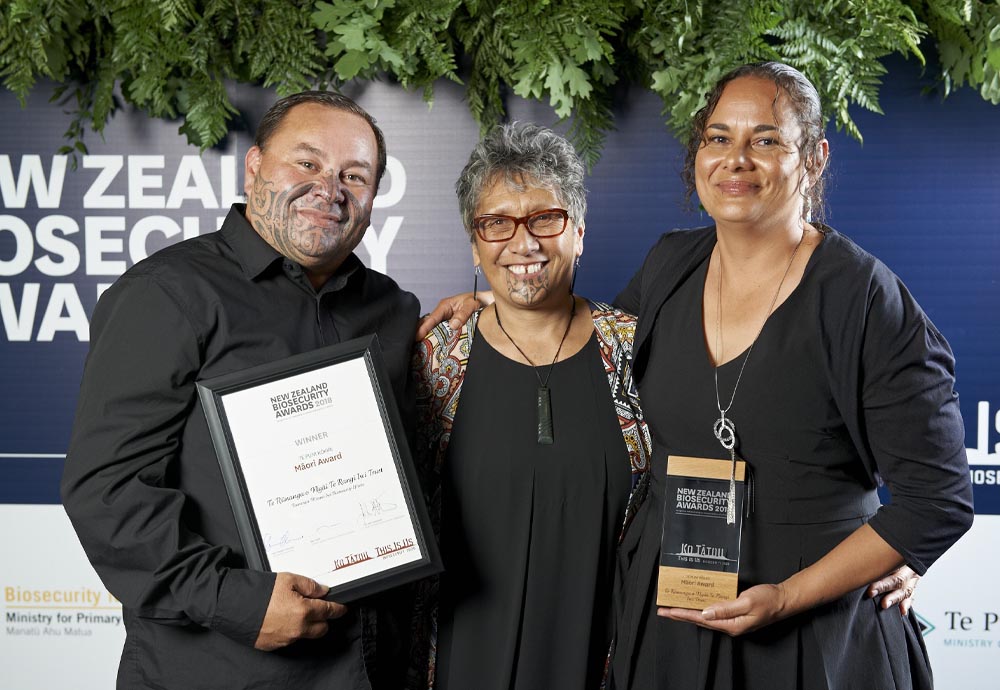
Project: Tauranga Moana iwi biosecurity efforts
Te Rūnanga o Ngāi Te Rangi Iwi Trust submitted this application to support Tauranga Moana iwi and to acknowledge the continued efforts that local kaitiaki are working on to build capacity and awareness in our communities, and to grow biosecurity excellence in Tauranga Moana.
The Trust does this work in anticipation of the incoming threats that are on our doorstep. With the growth of the Port of Tauranga, and horticultural and agricultural industries in the region booming, the Trust views this as a significant step in the protection of our 'taonga i tuku iho' (cultural treasures and heritage).
Finalist: Te Rūnanga o Te Rarawa - Te Puni Kōkiri Māori Award
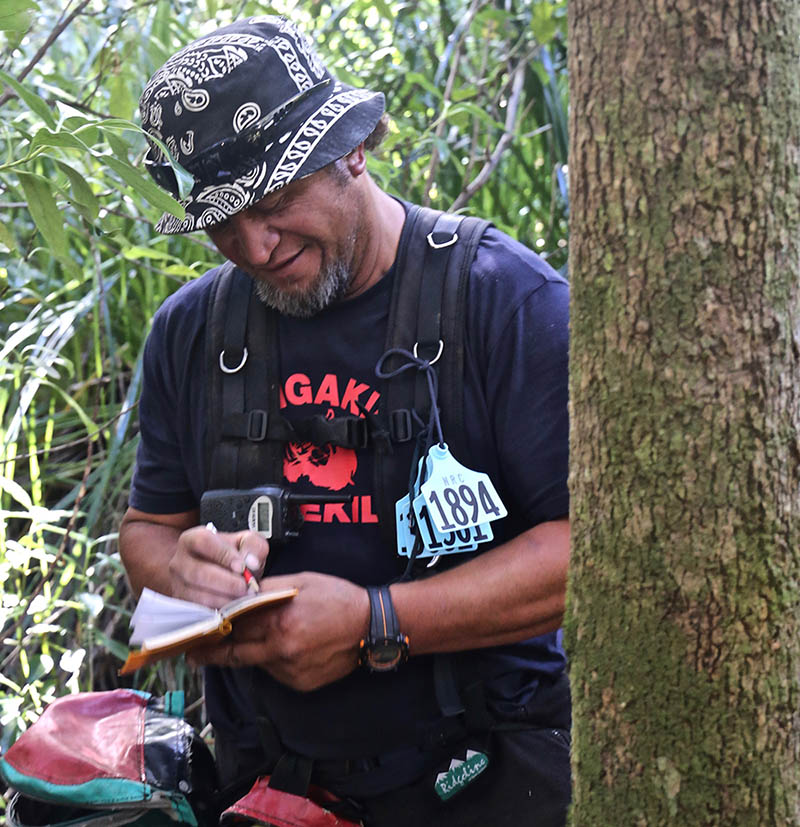
Project: Warawara Whakaora Ake
This project is an example of ground-breaking, collaborative restoration involving one of the world's most important kauri forests. It is a story of triumph over adversity and one that provides a living example of how patience, determination, and united community-led actions can bring about positive change.
Warawara ngāhere lies in the north Hokianga and is the spiritual heart of Te Rarawa. Mana whenua representatives from 10 local marae surrounding Warawara lead a plan involving 5 project partners (Department of Conservation, Northland Regional Council, Reconnecting Northland, and Te Rarawa Anga Mua iwi) to restore the health of Warawara across more than 13,000 hectares, while also revitalising local kāinga. The mana of the project rests with the local hapū, with the other project partners working in complementary supportive roles.
Comprehensive ecological survey work has been completed and pest control has been underway during the last 18 months. This has included preparing a plan for intensive predator control around populations of the rare titipounamu (North Island rifleman) along with training and skill development for local kaimahi.
The engagement of local mana whenua, in particular, the future problem solvers, has meant they are well-armed with a new awareness of the risks and opportunities which lie ahead.
Finalist: Te Kawerau Iwi Tribal Authority and Settlement Trust - Te Puni Kōkiri Māori Award
Project: Waitakere Rāhui
Te Kawerau a Maki, led by Te Wārena Taua, has shown bold leadership in announcing a rāhuifor Te Wao Nui o Tiriwa, the Waitakere Ranges, in December 2018, to prevent further spread of kauri dieback. This triggered nationwide media attention and community support, giving Auckland Council the confidence to close the Waitakere Ranges in May 2018. The increased attention to kauri dieback has helped raise awareness that urgent action is needed, which the local community also stressed. This led to the support for a huge funding increase for the environment in the Auckland Long Term Plan, from $89 million to $311 million.
Government Industry Agreement (GIA) Industry Award
Winner: Kiwifruit Vine Health - Government Industry Agreement (GIA) Industry Award
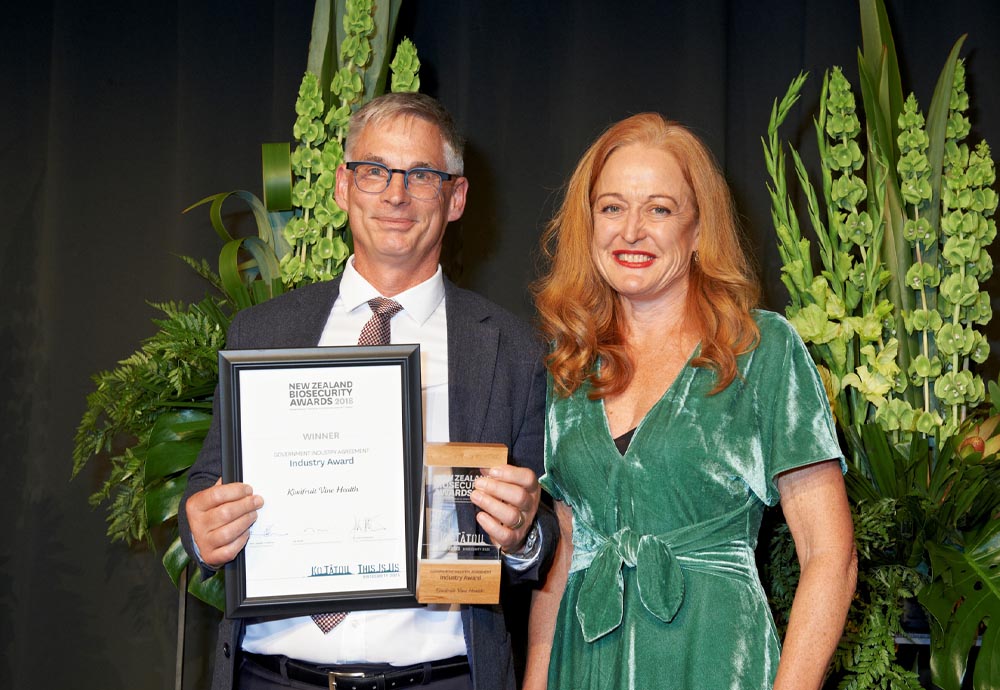
Kiwifruit Vine Health (KVH) is a leading biosecurity organisation, dedicated to supporting the New Zealand kiwifruit industry. Established in December 2010 by the kiwifruit industry to lead the industry response to the Psa incursion, the organisation is now responsible for managing all biosecurity readiness, response, and operations on behalf of the kiwifruit industry.
Analysis has shown that the cost of the Psa incursion could be up to $885 million over 15 years. Kiwifruit Vine Health's commitment to managing the Psa response for kiwifruit growers has contributed to the remarkable recovery of the kiwifruit industry just 8 years on from this incursion.
The organisation is a leader in biosecurity readiness and ensuring the industry is better placed for any future incursion, regularly having input into the New Zealand biosecurity system.
Finalist: Independent Verification Services (VIS) Ltd - Government Industry Agreement (GIA) Industry Award
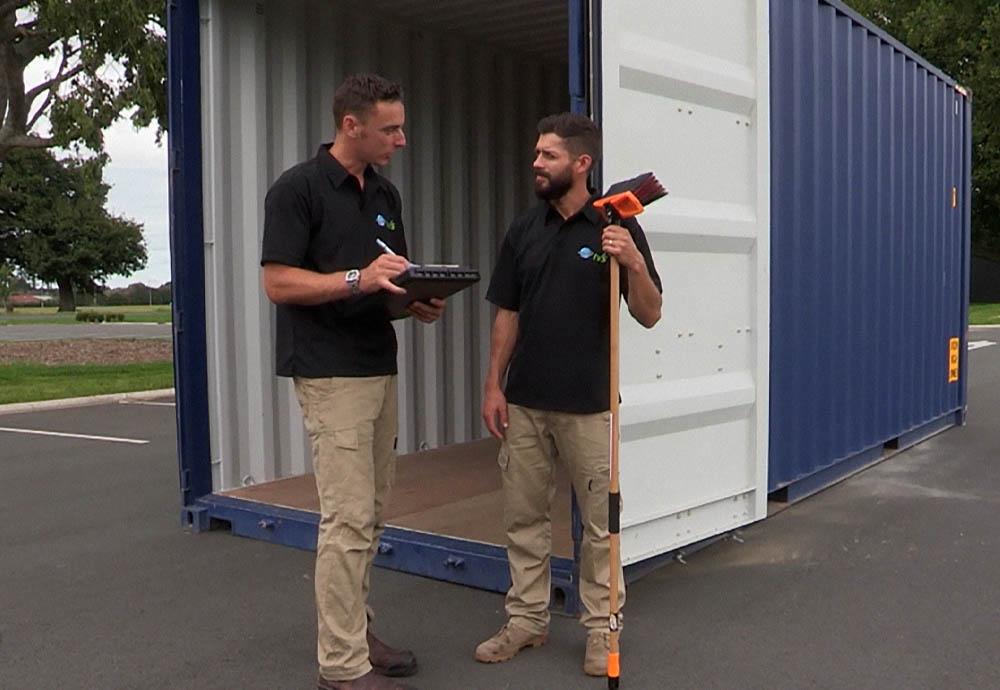
Project: MTF: Working in Partnership to improve biosecurity outcomes
In the interest of protecting our Taonga and strengthening New Zealand's biosecurity system, Independent Verification Services put forward an innovative solution that would also prove to be beneficial to industry: The Multi-Site Transitional Facility System (MTF). This system has facilitated the effective management of Transitional Facilities, allowing the Ministry for Primary Industries to focus on those importing large volumes of containers and in particular, facilities importing high-risk goods.
In doing this, the MTF system also provides importers nationwide with a cost-effective alternative to ensure that they can still receive containers directly, with the confidence that biosecurity requirements are being met.
Following the implementation of the MTF system, there has been a measurable reduction in biosecurity contamination entering New Zealand via sea containers. Where only 2% of contamination was being reported previously, MTF results have been consistent with the higher rates of contaminants found by Quarantine Officers.
The MTF system takes a proactive approach to biosecurity. It is now a key component of how we manage biosecurity risks, to stop pests and diseases before they enter the country and become a threat to our economy, natural resources or way of life. In this way, it contributes to the achievement of better biosecurity outcomes, which benefits all New Zealanders.
Finalist: Government Industry Agreement (GIA) Industry Award - Morven Action Group
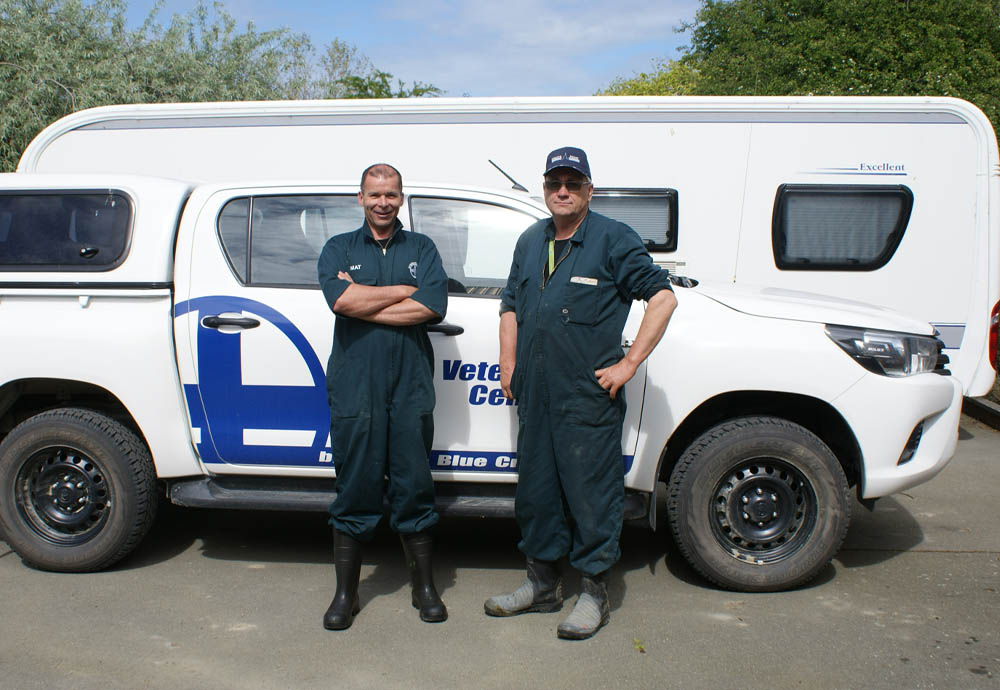
Project: Morven Action Group
The Morven Action Group was put together by South Canterbury dairy farmer Hugh Le Fleming and the local Veterinary Centre Oamaru with the aim of finding pragmatic ways farmers could protect themselves from Mycoplasma bovis. They were right in the middle of the area where the outbreak had first been identified and wanted practical information to protect their animals and farm businesses.
Together the farmers and veterinarians in the group sought out best practice information and put together both a Top 11 Checklist and Biosecurity Action Plan themselves, that farmers could use as a guide. Pragmatic and practical, it focuses on M. bovis, but is also relevant for many other biosecurity incursions.
The group's action plan was disseminated amongst South Canterbury farmers and shared at meetings and conferences with farmers in other regions.
Biological Heritage Challenge Science Award
Winner: Scion (New Zealand Forest Research Institute) - Biological Heritage Challenge Science Award
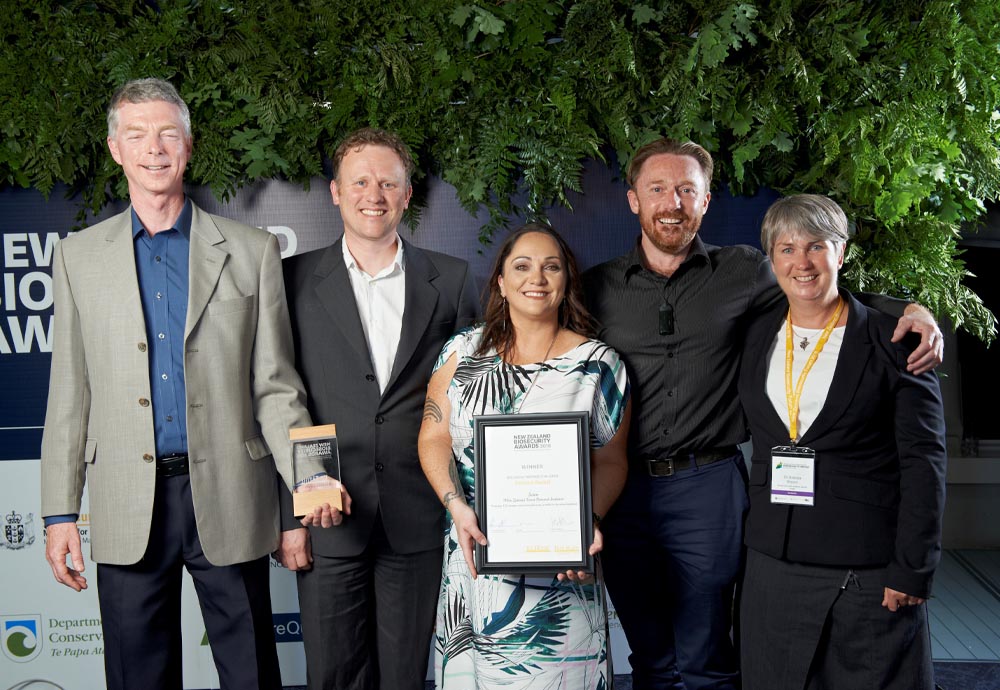
Project: Protecting New Zealand's primary sector from plant pests; a toolkit for the urban battlefield
Scion has developed novel approaches that will increase the effectiveness of eradication programmes for insect pests of plants, advancing the effectiveness of New Zealand's biosecurity system by creating world leading pest detection and eradication tools. Pest eradication will improve through:
- faster and more accurate identification of new pests. An exciting development is a world first tiny, lightweight mobile electroantennogram – an insect antenna combined with an electric circuit that senses miniscule quantities of insect pheromones. Scion implemented this on an unmanned aerial vehicle for rapid and widespread scanning of areas where insect pests may have spread.
- more effective methods of eradicating pests once they are found in New Zealand. Scion has significantly advanced targeted pesticide spraying tools, increasing efficacy and reducing amounts of spraying required, and developed a new fragmentation eradication model.
- ensuring social license so that eradication programmes can be rapidly implemented when pests are found. With Scion's Programme Steering Group from central and local government, primary producers and Māori, Scion has co-developed and tested tools that increase government-community engagement in eradication programmes.
Finalist: National Institute of Water and Atmospheric Research Ltd (NIWA) - Biological Heritage Challenge Science Award
Entry: Dr Graeme Inglis; leading marine biosecurity science
New Zealand's economy depends on maritime transport (more than 99% of our imports and exports travel by sea), but vessels of all types are also the main transport pathway for unwanted marine pests that threaten our sea-based industries, taonga and unique biodiversity.
Developing strategies to manage marine biosecurity threats while minimising impacts on trade requires robust, innovative science. Working closely with MPI, DOC, regional councils, vessel owners and many national and international collaborators for 18 years, Dr Graeme Inglis has led New Zealand's marine biosecurity research to achieve the best outcomes for New Zealand's current and future biosecurity system.
Finalist: Plant and Food Research, Auckland Council, Te Tira Whakamaataki, Biological Heritage National Science Challenge, Rongawhakaata iwi and Ngāti Ruapani ki Tūranga iwi - Biological Heritage Challenge Science Award
Entry: Dr Nick Waipara - Te Taura e Herea Nei te Pūtaiao me Te Ao Māori. Science Excellence in Biosecurity
Over the last decade, the name Dr Nick Waipara has become synonymous with kauri dieback. Through his various roles with Plant and Food Research, Auckland Council, Te Tira Whakamaataki and the Biological Heritage National Science Challenge, Dr Waipara has continuously advocated for science informing biosecurity policy, incorporating mātauranga Māori into scientific approaches to biosecurity threats, and involving mana whenua to help deal with biosecurity threats such as kauri dieback.
Mondiale Innovation Award
Winner: Jacson3 Limited - Mondiale Innovation Award
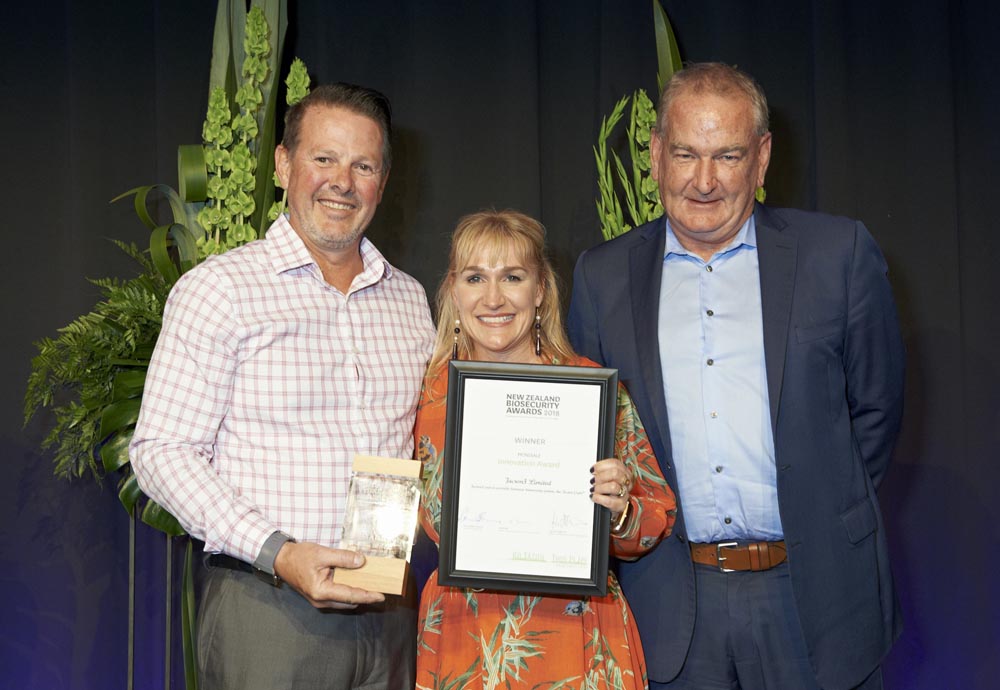
Project: Jacson3 and its portable footwear biosecurity system, the Jacson Cube®
Cleaned and disinfected footwear is an important and highly visible first step that sets the tone for biosecurity at the farm, orchard or nursery gate. Hamilton couple Rusty Knutson and Jacqui Humm have invented the Jacson Cube® (the Cube) – a portable footwear biosecurity system.
The Cube has been designed to improve existing 'clean and disinfect' footwear protocols so that they are faster, easier and safer to implement in a long-term, behaviourally-sustainable manner, particularly for rural professionals and others who move frequently between properties, but also for farmers and growers as a point-of-entry solution.
Finalist: Waikaitu Ltd - Mondiale Innovation Award
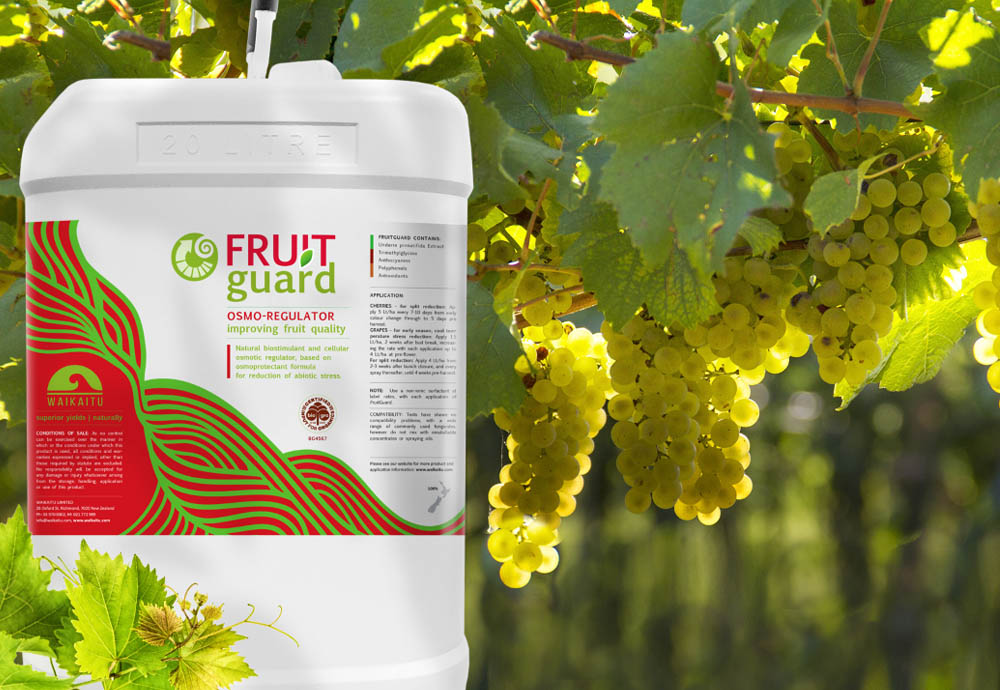
Project: Waikaitu Ltd – Fruitguard Osmoprotectant
Waikaitu is an agricultural organic chemistry company in Richmond, New Zealand. They sustainably harvest an invasive, nutrient-dense seaweed, Undaria pinnatifida, in Marlborough Sounds and create Bio-Gro certified organic plant and soil care products.
Waikaitu products decrease reliance on petrochemical fertilisers and crop protectants that pollute the environment, solving 3 problems: management of the pest species Undaria pinnatifida, environmental soil and water pollution reduction, and providing sustainable plant nutrition solutions.
Finalist: Mondiale Innovation Award - Te Kawerau Iwi Tribal Authority & Settlement Trust
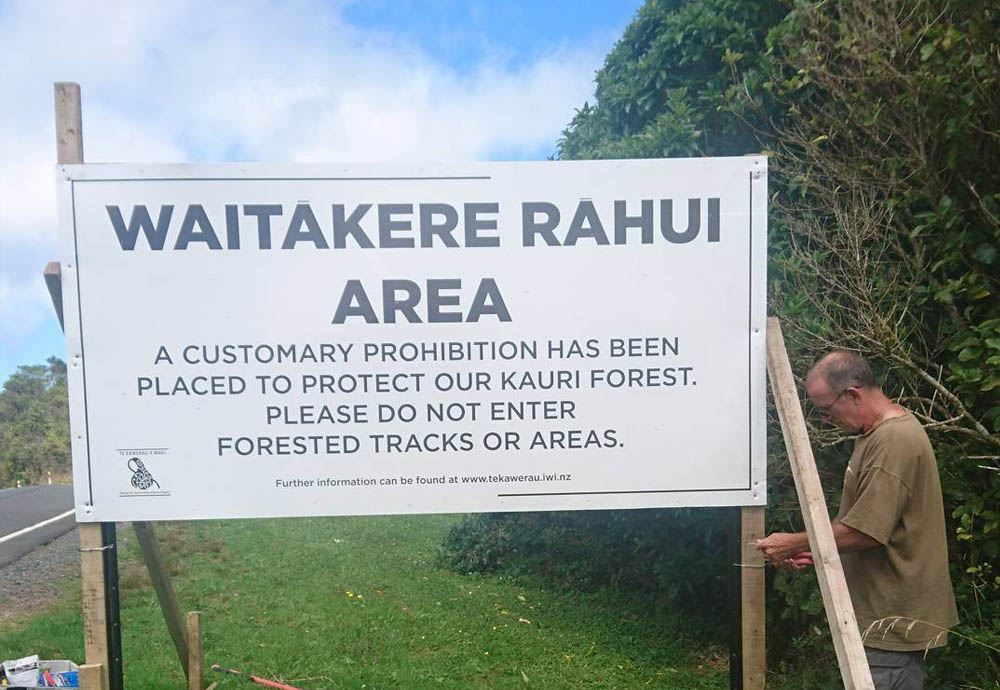
Project: Waitakere Rāhui
Te Kawerau a Maki, led by Te Warena Taua, has shown bold leadership in announcing a rāhui for Te Wao Nui o Tiriwa, the Waitakere Ranges in December 2018, to prevent further spread of kauri dieback. This triggered nationwide media attention and community support, giving Auckland Council the confidence to close the Waitakere Ranges in May 2018.
The increased attention to kauri dieback has helped raise awareness that urgent action is needed, which the local community also stressed. This led to the support for a huge funding increase for the environment in the Auckland Long Term Plan, from $89 million to $311 million.
AsureQuality Emerging Leader Award
Winner: Dr Amanda Black, Te Kawerau ā Maki - AsureQuality Emerging Leader Award
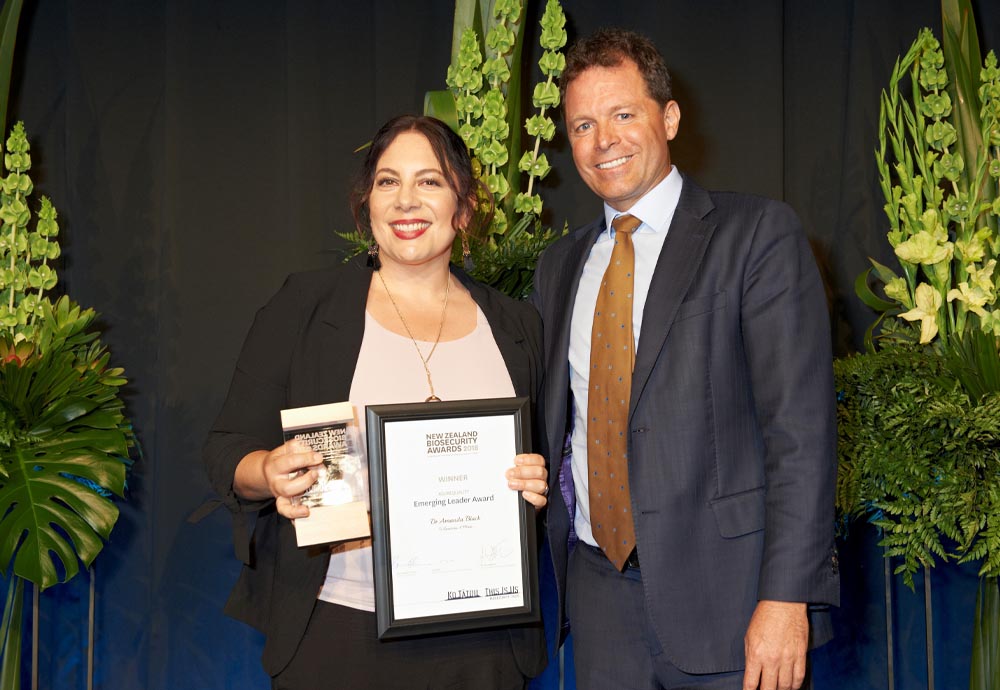
Amanda originally comes from Whakatane and is of Tūhoe, Whakatōhea, and Whānau-ā-Apanui descent. She is senior lecturer at the Bio-Protection Research Centre, Lincoln University.
Amanda has not only been a leading scientist in the biosecurity space, she has also been a voice for nature, making sure that the systems for biosecurity improve. She has been a key liaison with Māori in the biosecurity space working for Te Kawerau ā Maki. She is also on Te Roroa, Waipoua Forest Technical Advisory Group for Kauri dieback.
She was also a science leader for the Māori biosecurity programme in the Biological Heritage National Science Challenge. This funded myrtle rust and freshwater biosecurity research into freshwater mussels and kōura, and helped establish the Māori biosecurity network – Te Tira Whakamātaki.
Finalist: Sophia White, Northland Regional Council - AsureQuality Emerging Leader Award
Sophia is a young emerging leader at Northland Regional Council who has successfully led the development of a marine pathway plan for the whole of the Northland region during the last 18 months. The rules of the plan have been tested and upheld in the Environment court and serve as a template for greater marine protection throughout New Zealand.
Sophia has presented to ministerial select committees, fronted the scrutiny of the public and marine industry and led a dedicated team of four others in breaking new ground for marine pest action. She is a leader who inspires and encourages and has a dedication that others around her seek to match. As a young person who aims to continue her passion in marine protection, Sophia is acknowledged as one of New Zealand's finest emerging ambassadors for biosecurity and marine pest action.
